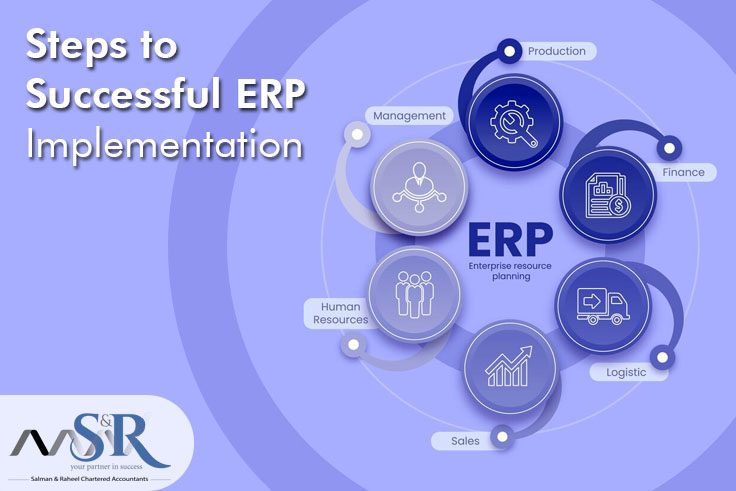
In today’s dynamic business landscape, Enterprise Resource Planning (ERP) systems have become indispensable tools for organizations seeking streamlined operations and enhanced productivity. Whether it’s managing finances, human resources, supply chain, or customer relationships, ERP software integrates these critical functions into a centralized platform, offering real-time visibility and data-driven insights. However, implementing an ERP system is a complex endeavor that requires careful planning, coordination, and execution. Without a clear roadmap, organizations risk encountering challenges such as budget overruns, delays, and disruptions to daily operations. To ensure a smooth transition and maximize the benefits of ERP adoption, it’s crucial to follow a structured implementation process. In this blog, we’ll delve into the key steps involved in the ERP implementation process, offering insights and strategies to help businesses navigate this journey successfully.
Objectives and Scope:
Before embarking on an ERP implementation journey, it’s essential to clearly define your objectives and scope. What specific business processes do you aim to improve or streamline with the new system? Are there any particular pain points or inefficiencies that need to be addressed? By outlining your goals and scope upfront, you can align stakeholders’ expectations and set the foundation for a successful implementation.
Objectives:
- To outline the essential steps involved in the ERP (Enterprise Resource Planning) implementation process.
- To provide a comprehensive understanding of the key components necessary for a successful ERP implementation.
- To offer insights into measuring the success and ROI (Return on Investment) of ERP implementation efforts.
- To equip readers with actionable strategies and tools to optimize the ERP implementation process and achieve business objectives effectively.
Scope:
- Introduction to ERP systems: Overview of what ERP systems are and their significance in modern business operations.
- Training and Change Management: Strategies for training end-users and managing organizational change to ensure smooth adoption of the new ERP system.
- Risk management: Identification of potential risks and challenges during ERP implementation and strategies to mitigate them effectively.
- Future trends and considerations: Insights into emerging trends in ERP systems and considerations for future-proofing ERP implementations.
Select the Right ERP Solution:
Choosing the right ERP solution is a critical decision that can significantly impact the success of your implementation. Evaluate various options based on factors such as functionality, scalability, vendor reputation, and compatibility with your existing systems. Additionally, consider factors like implementation timeframes, ongoing support, and total cost of ownership to make an informed decision.
Next, conduct comprehensive research on available ERP systems, evaluating features, functionalities, vendor reputation, and customer reviews. Request demonstrations and obtain quotes to compare offerings effectively.
During the selection process, prioritize solutions that offer customization options and robust support services to address potential challenges. Consider the long-term viability of the vendor, including their commitment to innovation and ongoing updates.
Furthermore, assess the ERP’s compatibility with existing systems and infrastructure to minimize integration complexities. Ensure adequate training and support resources are available to facilitate user adoption and maximize ROI.
Finally, negotiate terms and pricing agreements that align with your budget and implementation timeline. By following these key steps, you can navigate the ERP selection process with confidence and set the stage for a successful implementation journey.
Assemble a Cross-Functional Implementation Team:
To ensure the seamless integration of an Enterprise Resource Planning (ERP) system, assembling a cross-functional implementation team is paramount. This team should comprise individuals with diverse expertise spanning various departments within the organization. From IT specialists to finance professionals, procurement managers to human resources representatives, each member brings unique insights crucial for the successful implementation of the ERP system. Collaboration among these stakeholders fosters a comprehensive understanding of organizational needs, facilitates effective communication, and ensures alignment of goals throughout the implementation process. By leveraging the collective knowledge and experience of this cross-functional team, organizations can navigate the complexities of ERP implementation with confidence, driving towards a successful outcome.
Conduct Comprehensive Training:
Effective training is essential to ensure that end-users are equipped with the knowledge and skills needed to leverage the full capabilities of the ERP system. Develop a comprehensive training plan that caters to users at various levels of the organization, from executives to frontline staff. Consider offering a combination of classroom training, online tutorials, and hands-on workshops to accommodate different learning styles and preferences. Conducting comprehensive training is a pivotal step in ensuring the success of an ERP (Enterprise Resource Planning) implementation. Training plays a crucial role in equipping employees with the necessary skills and knowledge to effectively utilize the new system. It is essential to design training programs that cater to the diverse needs of users across different departments and levels within the organization. From basic navigation and data entry to more advanced functionalities, training should cover all aspects of the ERP system relevant to each user’s role. Additionally, incorporating hands-on exercises and simulations can enhance understanding and retention. Moreover, ongoing support and refresher training should be provided to address any questions or concerns that arise post-implementation. By prioritizing comprehensive training, organizations can empower their workforce to leverage the full potential of the ERP system, ultimately driving efficiency, productivity, and success.


